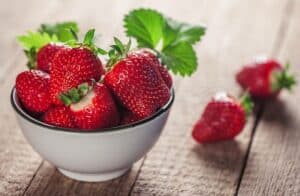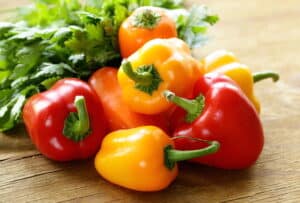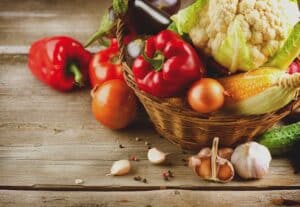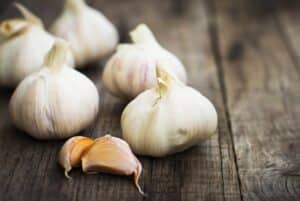[Contributed by Jill Nussinow, MS, RD, The Veggie Queen™] Whenever I mention that I teach pressure cooking and that I have a bunch of great pressure cooker recipes, people respond by telling me their memories about their mother’s or grandmother’s pressure cooker. Most have a horror story to tell.
So, let me tell you about my mother’s pressure cooker. Whenever Mom used her cooker I stayed away from the kitchen. The loud hissing noises and the rocking and shaking of the jiggler on top scared me. And the time that the food was blown all over the kitchen convinced me that I NEVER wanted one of those. But about 20 years later, I heard about the “new” pressure cookers and decided to give one a try. And even though I was interested, it still took a couple of years after my intention to actually get up the courage to buy one. Many of my students let their cookers languish in the box for months, but once they try out some delicious pressure cooker recipes, there’s no going back.
Now I have been cooking pressure cooker recipes for a decade and a half. I consider it one of my most essential pieces of kitchen equipment. I’ve even packed and hauled it for car camping trips, and taken it with me to do cooking demonstrations. It’s fast, uses less fuel or energy (saving 50 to 70) and best of all, it makes food taste great. You get that satisfying next-day taste of soups, stew and chili right away.
You save money by cooking dry beans instead of buying them in cans. It’s easy to eat more whole grains, since they cook in less than half the time of cooking on the stovetop. Fast cooking makes time spent in the kitchen more enjoyable. I can decide what to eat and have it on the table in an hour or less. Once you try these pressure cooker recipes, you might be hooked. As for explosions, those are only related to taste.
How the Cooker Works
Boiling water on the stove top takes place at 212 degrees F. Once you lock the lid on the pressure cooker and it comes up to 15 pounds p.s.i. (per square inch) the temperature inside the cooker climbs to over 250 degrees, resulting in hot steam. This process cooks the food much more quickly and causes food flavor infusion.
I prefer the “new” pressure cookers that have a spring valve instead of a jiggler. Usually they are stainless steel pots with triple-ply bottoms that work well, even as a large pot for stove top cooking. These cookers usually have at least four pressure release valves, so the lid is unlikely to blow off. If you have an older style, jiggler cooker and like it, then continue using it carefully.
The basic technique for using the cooker is to either add all the ingredients, lock the lid on and bring the contents to a boil over high heat to get to pressure, or to first sauté ingredients, add some liquid and then turn the heat up high. Once pressure is achieved, set your timer, lower the heat to maintain pressure and wait for the timer to beep. You will then either quick release the pressure (which is a major improvement in the “new” cookers) at the stove or run it under cold water. Or, if the recipe calls for it, you will use a natural pressure release, which takes from 5 to 10 minutes, depending on how much food is in the pot. Be aware that the food is still cooking during the natural pressure release. Always remove the lid, tilting it away from you to avoid getting burned by the steam.
You do need to be careful when making pressure cooker recipes with a naturally high sugar content, such as leeks, tomatoes and other tomato products, as they are more likely to stick to the bottom of the cooker and burn.
Choosing a Cooker
No matter which brand of pressure cooker you choose, remember that the pot can only be filled one-half to two thirds full, depending upon the pressure cooker recipes. For beans, stop at half full. I suggest choosing the largest cooker, 6-quart or more, that your budget and cabinetry will allow. You can cook 1 cup of rice in any size cooker but it might not be especially energy efficient to do so in an 8 quart cooker.
For a family of 1 or 2, a 4 quart cooker might do but a 6-quart ensures that you’ll be able to make enough for leftovers or freezing. An 8-quart cooker is great for a family of 3 to 4. If you regularly cook for more people, consider getting the big girl 10-quart cooking which can also be used for pressure canning, according to Fagor, a pressure cooker manufacturer.
Look for stainless steel pots with thick bottoms, with easy closing lids and quick pressure release features. These cookers will cost between $70 and $150 dollars, and you can often buy them on sale. If you find one for far less, you may want to thoroughly investigate what it can and cannot do.
No matter which cooker you buy, I always suggest that you start using it by putting in plain water and bringing it to pressure so that you can feel comfortable with it and how it reacts to heat and pressure. It will help prevent the potential of ruining food on your first couple of pressure cooker recipes. Or you can make vegetable stock (see recipe below) to start off.
Most cookers require a minimum ¼ to ½ cup water or other liquid to help them get to pressure. Be sure to follow the manufacturer’s recommendations. Pressure cooker recipes featuring watery foods such as summer squash, bok choy and mushrooms often contribute their liquid to the amount you add, so keep that in mind. Generally, the best dishes to prepare in a pressure cooker are soups, stews, chili, beans and grains. Quick cooking vegetables require you to pay attention but green beans in a minute, carrots in 2 or beets in 3 minutes make the momentary mindfulness worth it.
Here are a couple of my favorite pressure cooker recipes which I make at least once a week.
Pressure Cooker Recipes
Potatoes, Tofu and Vegetables for Breakfast or Anytime
(also known as 3-Minute Vegetable Medley Du Jour)
Serves: 4
What’s fresh at the market this week? Toss it in. In summer, I add tender green beans, squash and basil; in winter, butternut or kabocha squash and spinach. Whatever tingles your taste buds works. The potatoes take 3 mintues to cook so time your other vegetables accordingly. I hope that you learn to love this dish as much as I do. It’s my go-to meal for breakfast, lunch or dinner, at least once a week, yet it rarely tastes the same way twice.
Cooking Time: 2 minutes high pressure; quick release; 1 minute high pressure; quick release
- 1 medium onion, diced
- 2 to 3 small potatoes such as fingerlings or purple type, cut into 1-inch pieces
- 2 cloves garlic, minced
- 1 piece ginger root, minced or grated
- 1 carrot, peeled and cut on the diagonal
- ½ pound firm tofu, cubed
- 1 tablespoon tamari, Bragg’s liquid amino acids or soy sauce
- Any spice blend that you like such as curry powder, Mexican, Italian
- 2 to 3 tablespoons or more water or broth
- 1 ½ cups vegetables such as broccoli, chopped greens, Brussels sprouts, cauliflower, asparagus, cabbage
Heat the cooker over medium heat. Add the onion and dry sauté for about a minute, adding a tablespoon of water or stock as soon as the onion begins to stick.
Add the potatoes, garlic, ginger, carrots, tofu and tamari and sauté for 1 minute.
Add the spices and remaining water or broth. Lock on the lid and bring to high pressure. Reduce the heat to maintain high pressure and set the timer for 2 minutes. Quick release the pressure and stir in the greener and shorter cooking vegetables. Lock the lid back on and bring to high pressure again for 1 minute. Quick release. Carefully open the lid. Serve hot over whole grains such as red rice or quinoa, or on its own.
Simple Vegetable Stock or Broth
Makes: 8 cups
One of my all-time favorite pressure cooker recipes. If you’ve never made stock before, you’ll be surprised at the rich flavor, which adds body to any soup or stew. Giving up canned or boxed stock is easy when you can make your own so quickly. When you’re cooking with fresh vegetables, save the scraps, ends and pieces and use them to make great stock. Season it any way that you like.
It’s great to have homemade stock. When I double the recipe, I freeze half in zippered bags, freezer containers or ice cube trays. The stock cubes are great when you just need a couple of tablespoons for a recipe.
I prefer not to salt my stock, adding salt to taste when using it in cooking. Do remember to do this, as unsalted stock is bland compared to canned stock. Use stock anywhere that you would use canned or boxed broth.
5 minutes at high pressure; natural pressure release
- 1 onion, peeled and quartered
- 2 cups leek leaves
- 3 to 4 garlic cloves (optional)
- 3 carrots, cut into chunks
- 3 ribs (stalks) celery, cut into pieces
- 2 bay leaves (true bay not California bay)
- A few peppercorns or up to 1 teaspoon
- 2 sprigs thyme or savory, or other herbs of your choosing
(beware of using rosemary as it can be overpowering) - 10 to 12 cups pure water, depending upon the size of your cooker.
Put all the ingredients in the pressure cooker. Lock the lid in place. Bring to high pressure over high heat. Lower the heat to maintain high pressure. When five minutes is up, turn off the heat and let the pressure come down naturally.
Remove the lid, tilting it away from you.
Allow the stock to cool slightly. Then pour the stock through a strainer into containers (not directly into zippered bags). When you get to the vegetable matter, press it against the strainer to extract all the liquid and flavor. Cool and refrigerate for a few days, or keep in the freezer for up to 3 months.
Variation:
When I am cooking, I save vegetable scraps such as the tops of leeks, ends of carrots,, stems of mushrooms, odd pieces of celery and more, in a plastic container or bag in my refrigerator. If I have enough to make stock at the end of the week, I do. If not, I label the bag and put it in the freezer. When I go to make stock, I use 4 to 6 cups of these assorted vegetable scraps to make stock instead of using fresh vegetables. To this, I add the bay leaves, peppercorns and other herb sprigs and follow the standard recipe for making stock above. You can use the vegetable scraps even if they are frozen, as they will defrost quickly in the pressure cooker.
Jill Nussinow, MS, RD, aka The Veggie Queen™, is the author of The Veggie Queen™: Vegetables Get the Royal Treatment cookbook, stars in the pressure cooker recipes DVD, Pressure Cooking: A Fresh Look, Delicious Dishes in Minutes and will soon be releasing an ebook, The New Fast Food™: The Veggie Queen™ Cooks Whole Food Meals in Less than 30 Minutes. You can find out more about Jill and see even more pressure cooker recipes on her websites The Veggie Queen and Pressure Cooking Online.
- Explore VegKitchen’s other Green Kitchen articles, as well as the wealth of kitchen tips in the entire Healthy Vegan Kitchen area.






Abhi says
Pressure cooker usually saves time in cooking and does retain the nutritive value of food. It is guaranteed method of fast cooking. It is a universal fact that food cooked in pressure cookers tastes delicious. This cannot be contested. We cook food in pressure cookers every day.
mark keeler says
We use a pressure cooker as our \"go to\" camping stove. We make vegetable soups, chicken soups, and breakfast porridge.
A favorite trick is to cook a meal on the road and turn the pressure cooker off and let it cook on it\'s own for several hours.